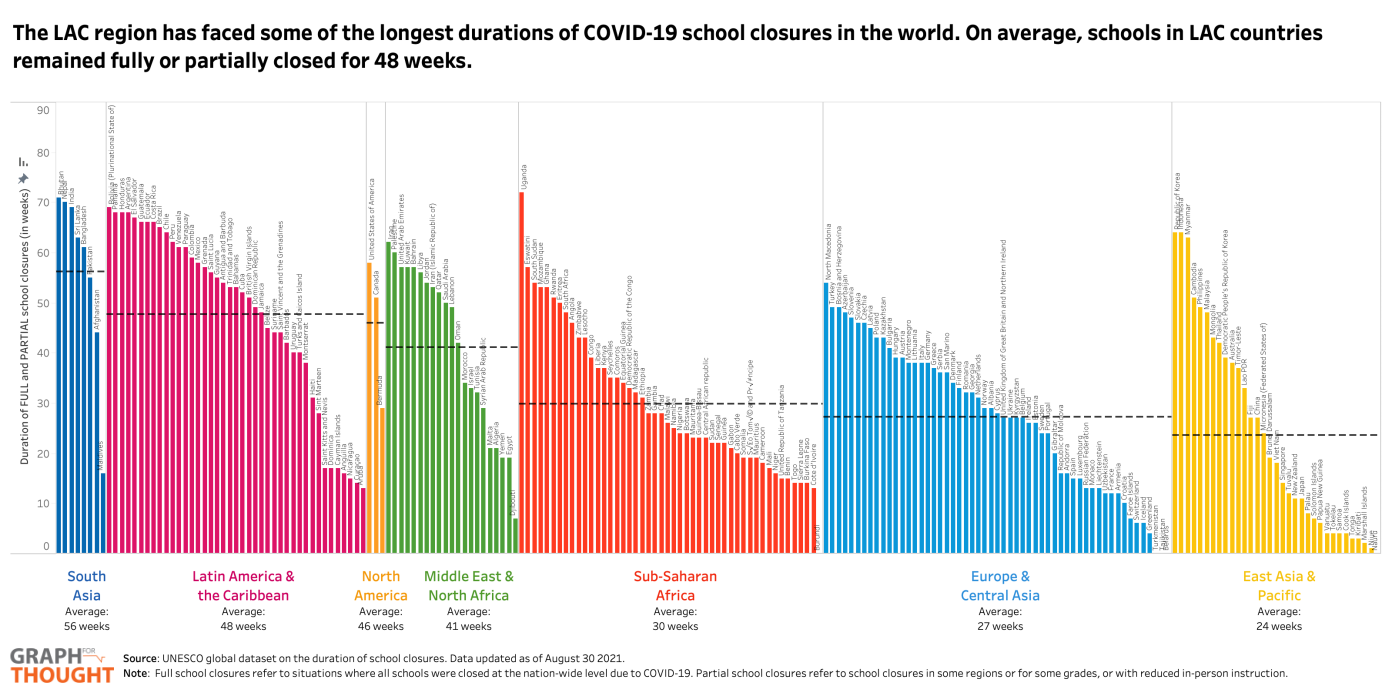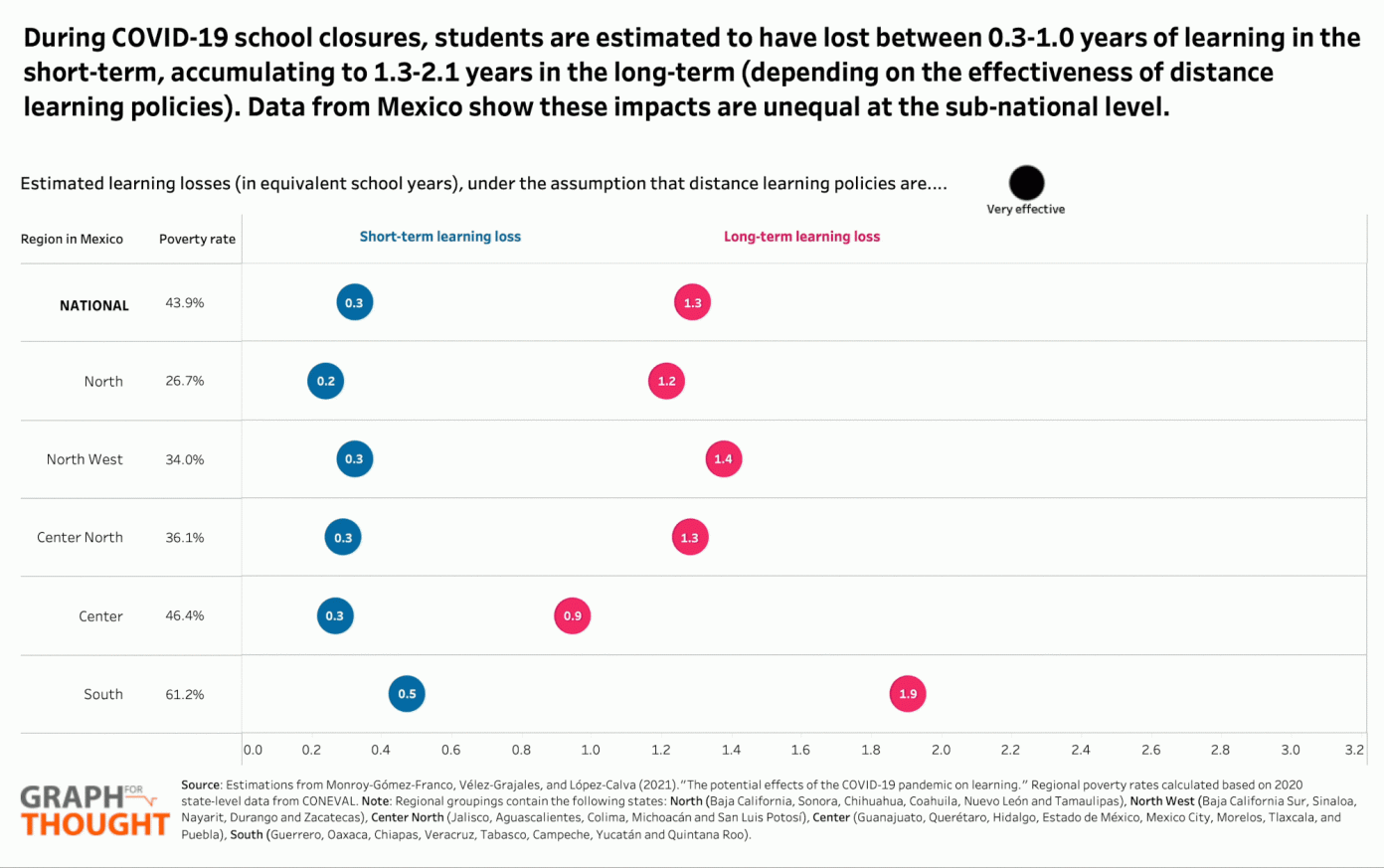Closing schools: Big and unequal learning losses in LAC
November 2, 2021
COVID-19 has taken a significant toll on education. In order to contain the spread of the virus, many governments had to make the difficult decision to close in-person schools. This was a necessary and life-saving measure in many contexts. However, it was not without its own adverse impacts. Prolonged school closures brought a multitude of challenges for students, ranging from to disrupted access to school meals to deteriorating mental health to learning losses related to distance-education programming. All of these carry critical implications for students’ human capital outcomes. As schools are beginning to reopen in many countries across the Latin America and the Caribbean (LAC) region, it is important to take stock of what these school closures have meant for students – and what it might mean for them in the future. This #GraphForThought specifically focuses on students’ learning outcomes.
Compared to other world regions, LAC has faced some of the longest durations of school closures during the pandemic. According to data from UNESCO, on average schools in LAC countries were fully or partially closed for 48 weeks. Only the South Asia region faced longer average closures. However, within the LAC region, there is a lot of heterogeneity—ranging from 69 weeks of closures in Bolivia to just 13 weeks of closures in Aruba. Generally, schools in Latin American countries tended to face longer closures than schools in Caribbean countries.

As in-person schools remained closed, children had to learn from home through distance-learning platforms—including online classrooms, television, and radio. We have long been discussing the potential impacts of this change for students, particularly on increasing inequalities in educational outcomes. As I elaborated in a previous #GraphForThought, this has the potential to both deepen intra-generational inequality (for example, a widening the gap between students who have access to digital technologies and those who do not) and reproduce inter-generational inequalities (for example, through the differences in at-home learning support that students receive based on how educated their parents are). But what do the data say about the actual impacts on learning? How many years of learning have students lost, and how does this differ across households?
Using the results from a recent paper I wrote in collaboration with Luis Monroy-Gómez-Franco (City University of New York /Centro de Estudios Espinosa Yglesias) and Roberto Vélez Grajales (Centro de Estudios Espinosa Yglesias) on “The potential effects of the COVID-19 pandemic on learning,” this #GraphForThought zooms in to answer this question. While the paper focuses on Mexico, given the availability of data, the concerns raised by the paper’s results apply more generally to the rest of the region. Note that in the paper we estimate learning losses in both the short-term (given students’ direct loss of schooling) and in the long-term (given the cumulative effects of this loss). It is important to remember that many of the pandemic’s costs could stay with us for a long time, and even compound, if we do not devise sufficient policy solutions.
The graph below shows the estimated short-term and long-term learning losses for a 6th grade student under three different “policy case scenarios” (depending on how effective distance learning policies are assumed to be). Even in the best-case scenario (assuming remote instruction was a perfect substitute for in-person instruction), we find that students lost the equivalent of 0.3 years of learning in the short-term, accumulating into 1.3 years of learning in the long-term. In the worst-case scenario (assuming remote instruction was the same as not attending school), we find that they lost the equivalent of 1 year in the short-term, accumulating into 2.1 years in the long-term. By exploring these results for different sub-national regions, we look at the unequal impact of the pandemic, with some households having more mechanisms to compensate for online learning, and find that students in the South (which is the poorest region in the country) face far worse learning losses than students in other regions.

As students return to in-person schooling across LAC, we need to remember that they will be returning with varying degrees of learning losses. We cannot just return to business as usual, assuming that students have learned as usual. They have not. Beyond distance-education challenges, students have suffered many other challenges that may have affected their learning—possibly including the loss of a parent or caregiver. To recover from the individual and social loss due to COVID-19 school closures, our region needs decisive compensatory action, investment and targeted strategies to prevent long term regressive impacts. This includes policies such as training teachers on how to accelerate learning among students that are falling behind, building schools’ capacity to support students’ new social-emotional needs, and building the infrastructure to prevent future disruptions. These policies also need to be sensitive to the large differences in the way these challenges manifest at the sub-national and household levels.

 Locations
Locations